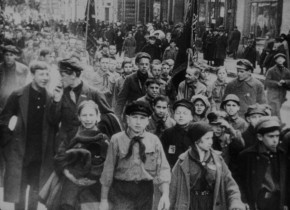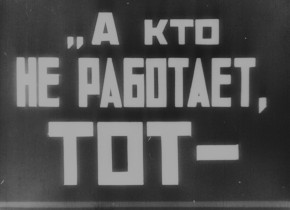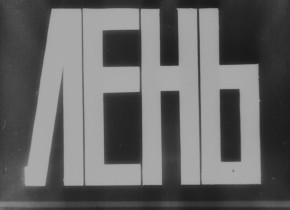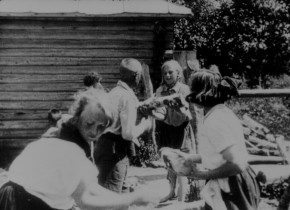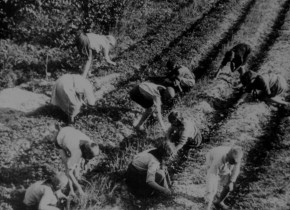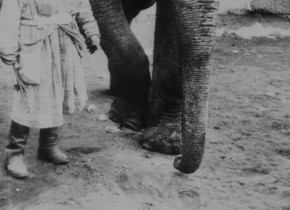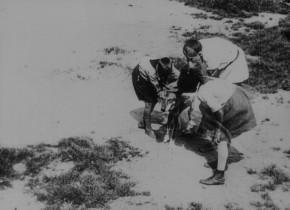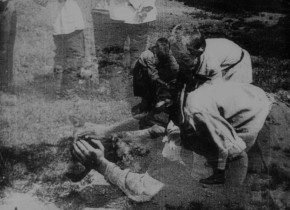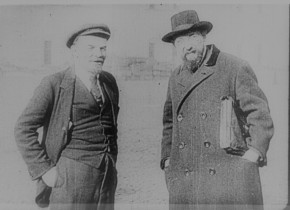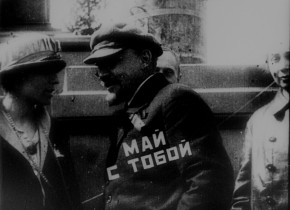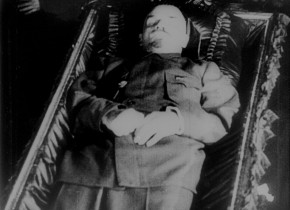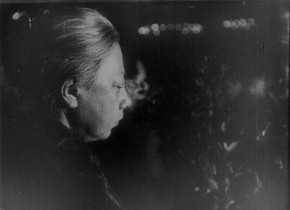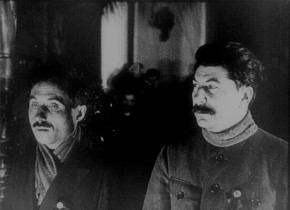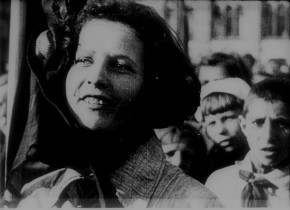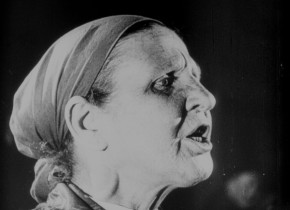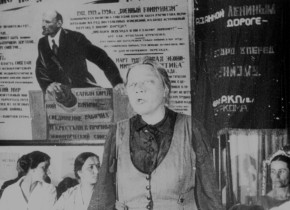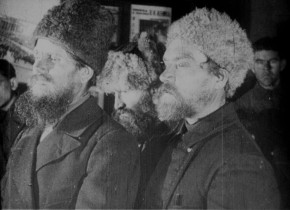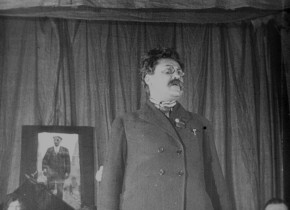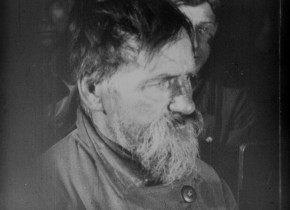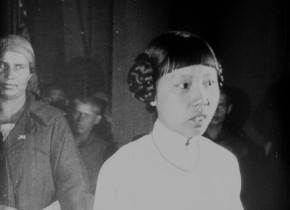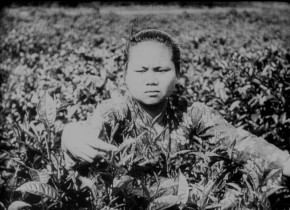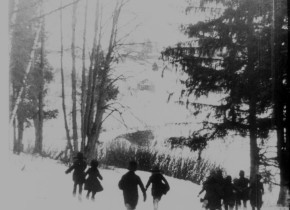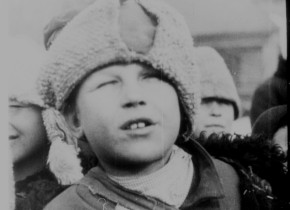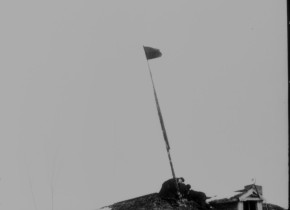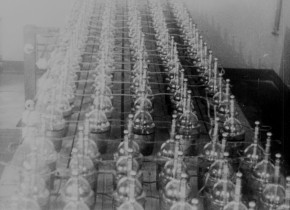Yuri Tsivian: Kino-Pravda No. 20–23 (1924–1925)
At different times Vertov felt like inventing a new emblem to illustrate the smychka concept. The simplest was a handshake with the word Smychka superimposed over it (seen in Kino-Pravda No. 21). A more entertaining one can be found in Soviet Toys, the one-reel animation film directed by Vertov and drawn by Ivan Beliakov and Aleksandr Ivanov. Here the alliance between workers and peasants is represented by a bizarre Siamese figure with four feet (two of which are wearing shoes made of bast fiber), two arms, and two faces (looking, Janus-like, in two opposite directions). This two-in-one master of Soviet land is shown admonishing his (their?) class enemy: the fat gluttonous bourgeoisie, whose main occupation is eating, drinking, and vomiting. Vomiting is represented by a railway (with a cute little train) shooting out of the mouth of the bourgeois, followed by the inscription: "He's gone to Riga." As Natal'ia Nusinova correctly observed, this image is a visual pun: in older times this phrase – "to go to Riga" – was used by some Russians to refer to this side-effect of gluttony and drinking. There is just one thing I must add to this unappetizing observation: the only reason why such a phrase was coined, was a phonetic similarity between the Russian word "rygat" – to vomit – and the name of a city known, in fact, to be one of the cleanest, greenest, most beautiful towns of the former Russian empire!
Made from footage left over from Kino-Eye and released after it, Kino-Pravda No. 20 should be seen as its mini-sequel, a Kino-Eye II, as it were, but compared to Kino-Eye this Kino-Pravda is less ideologically charged, more relaxed, pleasantly trifling. We run into familiar Young Pioneer characters like "Little Smoked Sprat" and "The Gypsy Kid" – captured fondling the youngest of the Pioneers, a four-(or-something)-year-old toddler (thus, a 100% New Person – for he or she was born after October 1917!). Our darling elephant is back too, now in his artificial habitat, the zoo, showing the things he can do with his trunk. If you recall the heavy political load of smychka – alliance – explained before, you will appreciate the humor of the sequence introduced by the title "Smychka so zver'mi" – alliance with animals – in which our Young Pioneers, enthralled, if a little tense, are shown hugging a wolf, and being hugged by snakes. There is also an unexpected pun ascribed to a bearded peasant who tells our Young Pioneers how to work. "The one who works is Lenin, the one who does not is lazy," he says, and everyone laughs, for the Russian for "laziness" is len.
In terms of film style, the most remarkable sequence in Kino-Pravda No. 20 is the railway journey sequence, whose rapid editing and rushing landscapes look almost like a tribute to Abel Gance's La Roue (that Vertov condemned fiction films does not mean he did not learn from them). Don't be nonplussed by the fact that the film comes "in five dispatches": the allusion is to mock-military dispatches ostensibly sent by the Pioneer unit to their old friend and comrade, the Kino-Eye.
Kino-Pravda No. 21 – Lenin Kino-Pravda. A Film Poem about Lenin is a special, longer-than-usual issue of Kino-Pravda made to mark the first anniversary of Lenin's death. It consists of 3 parts, announced laconically by I, II, III, and of smaller sections marked by no-less laconic references to years. The one-two-three structure relates the film's narrative to the famous Hegelian (now also Marxist) dialectical triad. Part I begins with Lenin being wounded by an S.R. assassin (1918); goes on from there to "1919" – the year when the Red Terror policy was declared by the Bolshevik government in response; the "1920," "1921," and "1923" sections are organized around shots of Lenin speaking, intercut with quotations from his speeches and documentary shots which illustrate Soviet Russia's progress under Lenin's leadership. This is the thesis. Part II is the antithesis, about the decline in Lenin's health.
We see the title "1922–1923," and then the words: "The iron leader is ill." The course of his illness is represented in what can be seen as a tour de force, Vertov and Rodchenko's animated titling: we see a table of sorts, with a calendar for dates, a clock for counting the hours, a graph showing the temperature, and two pulsating lines representing Lenin's pulse and breath rate. The bottom-line inscription says "General state satisfactory," but note how this word – "satisfactory" – is being split by an ominous slit. Then follows the funeral sequence, famous for its antiphony of images and titles; then, the no-less famous progression of mourners: wife, sister, Stalin, etc. – and then, 200,000 – 400,000 – 700,000. Note the way in which the size of the font grows with the size of the figures; note also the size of the font for "Stalin." Remember the all-Union funeral from the 1922 Kino-Pravda No. 13? Vertov already knew how to transform funerary footage into an affecting film.
Part III was designed to serve as the synthesis of I and II. It looks at the year that has elapsed since Lenin's death. "Lenin is gone, but his strength is with us," says the title. The most remarkable thing about this part (and, for me, about this film) is the boldness and ease with which Vertov jumps between newsreel and drawn animation. An animated caricature lasting 30 meters shows the face of a Capitalist changing from gloating to despair – as he sees more and more people, crowds of them, join the Communist Party after Lenin's death (there was a recruitment campaign, exhorting people to join). Note how the animated stream of workers willing to join the Party turns into a photographed one. Peasants are not forgotten, either: we are shown how a worker and a peasant shake hands, then there is a close-up of their handshake with the word smychka superimposed on it.
Kino-Pravda No. 22, entitled Peasant Kino-Pravda, is all about smychka, the much-desired political alliance between workers and peasants, between the city and the countryside, which Soviet leaders believed Socialist Russia would thrive on. According to Marxism, the peasant class is progressive but backward; it needs the guidance of the worker class to hit the mark. In keeping with this view, Russian peasants were stereotyped as good-hearted, crafty, but slow-thinking bearded men, who required a special approach and extra agit-prop effort in order to be fully converted. This issue of Kino-Pravda (a politically commissioned film, I am sure) was part of this extra effort. Its first subtitle – Peasant Kino-Pravda – means "pravda [truth] made for the peasants"; the second one – Lenin Is Alive in the Heart of the Peasant – sums up its simple message; and the third one, A Film Story (in contrast to Vertov's usual "film experiment"), signals that this issue (distinct from the previous one) will not be testing new grounds in film form. And it does not.
A group of peasants visit Moscow, talk to workers, file through Lenin's mausoleum, are shown the Kremlin, and visit the Museum of Revolution. The second half of the film is less didactic, however, and should be seen as Vertov's rough draft for his 1934 Three Songs about Lenin: in it, the oppressed nations (found-footage of Asia and Africa is used) pay tribute to Lenin (via direct-speech intertitles, in which Vertov puts words in their mouths).
Less than a third survives of Kino-Pravda No. 23 – originally 1400 metres long – which, as it happened, turned out to be the last. As its subtitle indicates, it is about that exciting new medium, radio, and its propaganda potential, particularly important for Russia's vast countryside. The beginning is missing in the available footage, but a title list survives, from which we can judge that this was a classic smychka gambit. The film begins in a city, at a working-class site. A title sets the scene: "A meeting of commissars outside a factory." The following series of intertitles convey what the politically educated workers' commissars think of peasants, and how they decide to act: "Luring peasants into a reading room is very difficult, to say nothing of women, who are unable to leave their chores," one says. "Installing radio receivers would add life to the situation," adds another. There follows a title, "In the radio shop," and a dialogue ensues between a shop assistant and a peasant who has come to buy a radio receiver: "Will we be able to hear anything in our village, 60 versts away?" "Not only 60 versts but 600 versts." It is here that the surviving part of the film begins – the peasant buys the radio, but there is no antenna in his village. How to get one? The film becomes instructional: go to the woods, chop down a tall tree, make a mast, raise it (via time-lapse animation), and so on. Watch out for Aleksandr Bushkin's brilliantly animated scene, in which a cross-section of a photographically correct izba [Russian peasant's log hut] is penetrated by schematically charted radio waves. It seems almost symbolic that the last issue of Kino-Pravda is called Radio Pravda – as if Vertov wanted to pass on the baton to the younger medium – even though we know it was not upon Vertov's initiative that the series was terminated.
From: Yuri Tsivian, Catalogue "Le Giornate del Cinema Muto," Sacile/Pordenone 2004
<< Tsivian on Kino-Pravda: No. 15–19
<< back to overview
